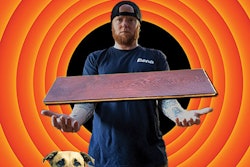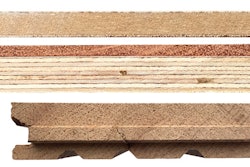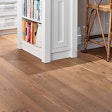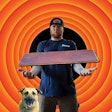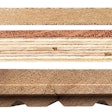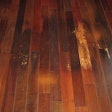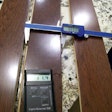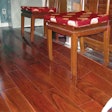When the Sander Sits
When I'm done sanding for the day, is there anything I should do to my sander when it is sitting idle?
Don Smithson, of Lake Oroville, Calif.-based J & D Smithson Repairs, answers:
Yes, a bit of preventive maintenance will help keep your sander in tip-top shape, helping you avoid costly repairs in the future:
- Disconnect the power cord from the power supply. Check the plug ends where they plug into both the power supply and the machine. Check for arc marks and looseness. Inspect the cord for cuts in the insulation. Repairs must be made before the sander's next use.
- Empty the dust bag into a fireproof container.
- One of the most important things is to loosen the paper. Be it a belt sander or a drum sander, this is necessary. The reason for this is that when the drum is hot from sanding, leaving the paper tight will leave a flat spot on the belt sander. On a drum sander, leaving the paper tight where the paper goes into the slot will make the slot wider. The edges of the drum slot will tend to be rolled over. This can cause chatter marks on the floor.
- The sander should not be stored on the wheels. Storing a sander on the wheels will cause flat spots. An exception to this rule is if your sander has steel wheels.
- Loosen the belts. When the machine is hot and put away with the belts tight, the belts will take a set in the position that they are left in. This can cause vibrations.
- On belt sanders, always inspect your top roller in between jobs. Look for sawdust, and check the bearings on the top roller and guide rollers. Look for debris, such as filler or mastic, that may be stuck to the top roller or drum, and clean off if necessary.
Wax On?
When I'm going to wax a floor, do I have to use a sealer first? Can't I just wax it?
Daniel Boone of Jacksonville, Fla.-based Daniel Boone WFT Inc., answers:
There are some species that you can get away with using only wax on, without a sealer, but for most wood flooring, you'll want to use a sealer first. There are a couple reasons for this. When you are first putting finish on a newly sanded floor, sealer lets you get a build on the floor right away. If you don't use one, the bare wood will keep absorbing the wax, and you'll need to put on four or five coats before you have any build on the floor.
Another even more important reason to use a sealer is that it improves the appearance of the floor long-term. If you use only wax, it will look fine at first, but after a short time-even just a month-it will start to get a dull, dingy look, and water spots will be very noticeable, with a grayish look.
One of the most popular sealers used under a waxed floor is shellac. Premixed shellac comes in three types: amber, clear or universal shellac. Amber and clear both contain waxes, but universal shellac, which is also referred to as universal sealer, is dewaxed. A huge benefit of shellac is that it dries rapidly: If you know how to apply it correctly, it goes on super thin and super quick, and it will flash off in 30 minutes. Just be careful using it, because its alcohol solvents are very flammable.
There are many other sealers that can be used under wax, including penetrating sealers, stain/sealer combinations and some urethanes. Before you use a sealer under wax, check the manufacturer's recommendations, because some sealers are dangerously slick when used with wax.
Prefinished Puzzler
Is there a difference between a "factory-finished" and "prefinished" floor?
Glen Miller, manufacturer division manager at the National Wood Flooring Association, answers:
In practice, the two descriptions have always been used interchangeably in the wood flooring industry, but technically they don't mean exactly the same thing. In general, they both basically mean that the finish is applied and allowed to dry prior to the actual installation. That is the only thing the two terms have in common.
A "prefinished" floor has finish on the top of the wood that is typically applied by the wood flooring contractor after finalizing what stain and finish the homeowner may want-but before the wood floor is installed. This is typically accomplished in a warehouse or shop, and the finish is allowed to dry just like it would on a site-finished floor. The individual applying the finish will attempt to follow the finish manufacturer's recommended spread rate (although this is sometimes hard to accomplish). Any warranty is offered by the company that applied the finish.
A "factory-finished" floor is accomplished using a controlled process throughout the entire operation. Sanding, staining, finishing, and drying is done using controlled devices to ensure the proper spread rate and drying of the wood prior to grading and boxing of the product. The flooring manufacturer will then warrant the floor for a specified amount of time based upon the type and amount of finish applied.















